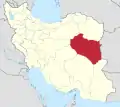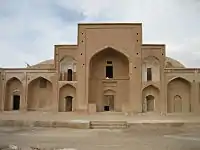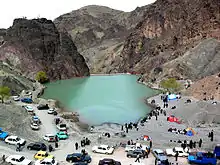Qaen
Qayen (Persian: قائن, also Romanized as Ghayen, Qaen or Ghaen; from Middle Persian: kʾyyn Kāyēn)[2] is a city in and the capital of Qaen County, in South Khorasan Province, Iran. The population at the 2006 census, was 32,474 in 8,492 families.[3] Qaen is also called the City of Saffron because it is a major saffron producer and saffron from Qaen is prized for its unique aroma and strong colour.
Qayen
قاین Qaen, Ghayen | |
|---|---|
City | |
 | |
| Motto(s): Qayen is the capital of red gold (saffron) | |
 Qayen Location of Ghayen in Iran | |
| Coordinates: 33°43′36″N 59°11′04″E | |
| Country | |
| Province | South Khorasan |
| County | Qaen |
| Bakhsh | Central |
| Population (2016 Census) | |
| • Total | 42,323 [1] |
| Time zone | UTC+3:30 (IRST) |
| • Summer (DST) | UTC+4:30 (IDST) |
Geography
A mud wall surrounds the modern town with more affluent residential areas lying outside the wall. The surrounding area consists of hill ranges of 9,000 feet (2,750 m) running northwest–southeast and sinking to the Sistan depression in the south.
The city is a trading center, but it also has industries that produce felt and carpets. The area is the main source of saffron in Iran. The other landmark fruit of this city is barberry. Lately most of the barberry produced in Iran was produced in the city; more than 90% of barberry production is happening here. The most famous and oldest industry in the city is Ghayen Cement Plant, producing more than 2000 tons of different types of cements daily and one of the leaders of cement exporting in the east of Iran.
History
The present city, which lies in a broad valley, was founded in the 15th century on the site of an ancient city. Later, the Uzbeks (a Turkic people) took possession of the city and held it until Shah Abbas I (1588-1629) expelled them. In the 18th century, Qaen fell under the control of Pashtuns which is why some of locals, though they speak Persian, still claim descent from Pashtuns rather than Persians.
There are several ancient places around the town, such as the Tomb of Bozorgmehr Qaini, 5 km to the south.
The Middle Persian work Shahrestaniha i Eranshahr mentions this city, and attributes its foundation to the legendary king Kai Lohrasp.[4]
At least 1.567 people in Qaen and the surrounding region were killed in the 1997 Qayen earthquake.
References
- https://www.amar.org.ir/english
- Qaen can be found at GEOnet Names Server, at this link, by opening the Advanced Search box, entering "-3078747" in the "Unique Feature Id" form, and clicking on "Search Database".
- "Census of the Islamic Republic of Iran, 1385 (2006)". Islamic Republic of Iran. Archived from the original (Excel) on 2011-11-11.
- https://archive.org/stream/SahrestanihaIEransahr/Šahrestānīhā%20ī%20Ērānšahr#page/n49/mode/2up



